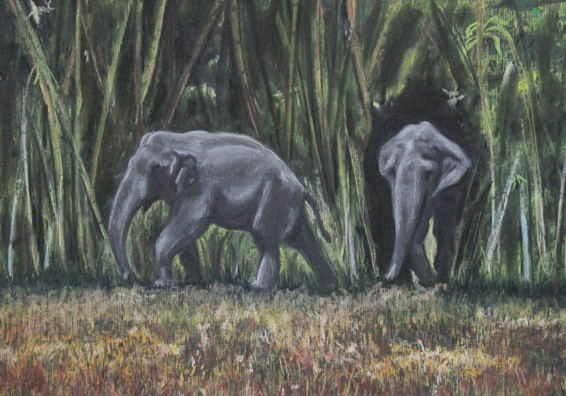Indian Elephants

Indian elephants - Elephas maximus indicus - live in (where else?) the Indian subcontinent.
Originally it was thought that in the evolutionary pathway that mammoths led to the Indian and African elephants. However, DNA tests have led to different researchers reaching different conclusions. Some say the Indian elephant is closer to the mammoth than to the African. But others say it's the other way about.
The Indian elephants average about 9 feet and the African about 11 ½ feet. The mammoth stood over 12 feet and the mastodon - an American elephant - not quite 10. Mastodons, mammoths, and about 75 % of the other large mammals went extinct about 11,000 - 12,000 years ago at the end of the Pleistocene period. Exactly why the mammals died out fairly quickly isn't really understood. Theories vary from climate change, humans, and a large comet exploding in the atmosphere.
Interestingly, small mammoths - four to six feet tall - lived in a number of places ranging from Siberia to the Mediterranean. Most of them seemed to have died out at the end of the Pleistocene period with most of the other large prehistoric animals. But a small community lived on Wrangel Island in the Chukotski Autonomous Region north and east of the Bering Strait until about 2,000 BC.
Elephants, though, are still around. There are quite a few but are still considered threatened. Poaching - mostly for the illegal ivory trade which funds organized crime and terrorism - remains a big problem.
Elephants have the largest brain of any land animal and based on total size and the number of neurons should be smarter than humans. They can be taught to paint - and some of their art is a lot better than what you see in art galleries (and some of it you can see in art galleries). But if you count the number of neurons in the cerebral cortex, the ranking would be: humans > chimps > elephants.
So that's why we don't see elephants acting exactly like people. After all they never sit down on a couch, eat a whole bag of chips, and watch Dancing with the Stars.
Hm.
References
"The Elephantidae: Elephants and Mammoths", University of California Museum of Paleontology.
"Pleistocene Epoch: Facts About the Last Ice Age", Kim Ann Zimmermann, Live Science, October 9, 2015.
"The Paradox of the Elephant Brain With three times as many neurons, why doesn't the elephant brain outperform ours?", Suzana Herculano-Houzel, Nautilus, April 7, 2016
"Holocene Dwarf Mammoths from Wrangel Island in the Siberian Arctic", S. L. Vartanyan, V. E. Garutt, and A. V. Sher, Nature, Vol. 362, pp. 337 - 340, (1993).